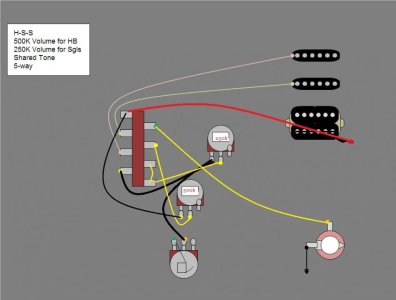beaubrummels
Well-known member
Re: Gaps in the Wiring Diagrams?
Haven't had a chance to work on the HSS 500k/250k one. But in the meantime I'll contribute this. This is the Jimmy Page wiring that follows the behavior described for Gibson's Jimmy Page #2 Les Paul. (The Duncan diagram doesn't have all the options possible, and I believe there is an omission/error in the Duncan one.)

Note: this wiring scheme has an artifact that for series, the pickup selector switch needs to be in the middle position. In the neck position, you'll get nothing, in the middle or bridge position it will work as expected. There are versions of this wiring that avoid that problem, but my understanding is the Gibson guitar has this same issue. (Though one could argue it's user error to expect two pickups in series when only one is selected on the switch.)
This is an alternative version I have in my SG right now. I moved the split coil to the two pickguard switches because it's less wires through the channel.

There are number of different ways to get these options. There's a guy named Hermetico on here that has a good one that utilizes the PRail scheme where the Vol/Tone switches are wired to allow controlling which coil is used for single. Myself I've done about 15 different Page diagrams trying to work out the easiest to wire / easiest to use versions. These two may not be the best for you. Feel free to suggest improvements.
Haven't had a chance to work on the HSS 500k/250k one. But in the meantime I'll contribute this. This is the Jimmy Page wiring that follows the behavior described for Gibson's Jimmy Page #2 Les Paul. (The Duncan diagram doesn't have all the options possible, and I believe there is an omission/error in the Duncan one.)

Note: this wiring scheme has an artifact that for series, the pickup selector switch needs to be in the middle position. In the neck position, you'll get nothing, in the middle or bridge position it will work as expected. There are versions of this wiring that avoid that problem, but my understanding is the Gibson guitar has this same issue. (Though one could argue it's user error to expect two pickups in series when only one is selected on the switch.)
This is an alternative version I have in my SG right now. I moved the split coil to the two pickguard switches because it's less wires through the channel.

There are number of different ways to get these options. There's a guy named Hermetico on here that has a good one that utilizes the PRail scheme where the Vol/Tone switches are wired to allow controlling which coil is used for single. Myself I've done about 15 different Page diagrams trying to work out the easiest to wire / easiest to use versions. These two may not be the best for you. Feel free to suggest improvements.





